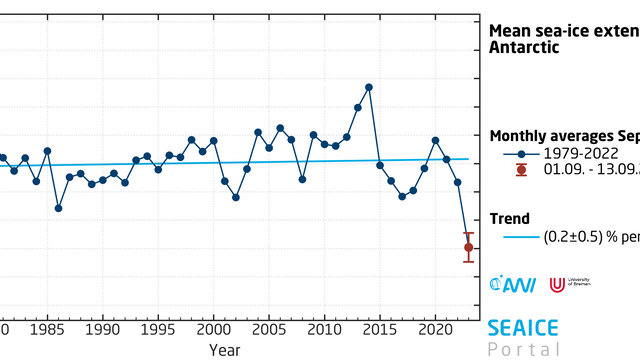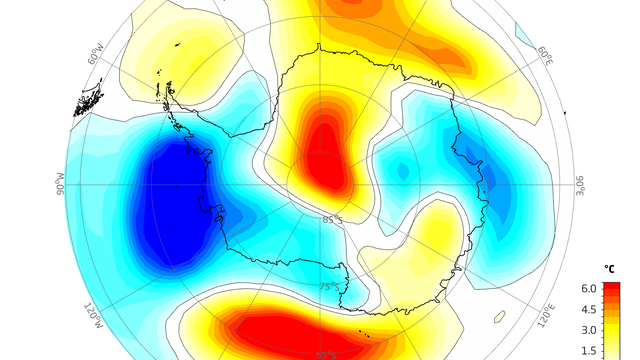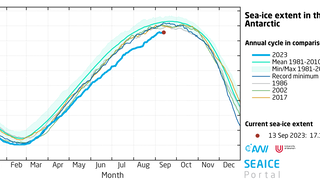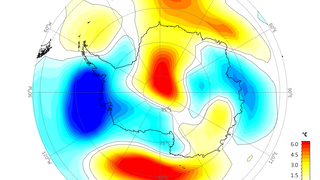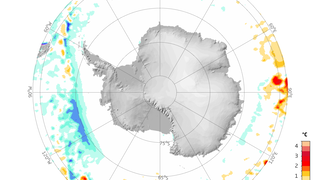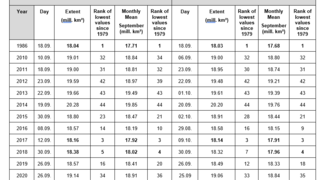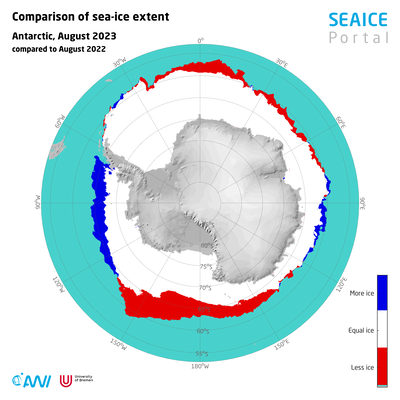In the polar regions, sea ice follows a distinctly seasonal cycle, and every year roughly 15 million square kilometres of ice are formed and melt in the Antarctic. But this winter, the ice growth has been extremely sluggish and, since the beginning of the year, the Antarctic sea-ice extent has been at the lowest level since the beginning of continuous satellite observation in 1979. In addition, on 19 February 2023 the minimum sea-ice extent in the Antarctic hit a new record low of just 2.0 million km², while also dropping below the previous all-time low monthly mean value from 2022. On 7 September, the Antarctic sea ice reached 17.16 million km² – the lowest maximum extent ever observed in winter and ca. 880,000 km² below the previous record from 18 September 1986 (a difference roughly two-and-a-half times the size of Germany; see Figure 1). The monthly mean for September 1986, at 17.71 million km², was the lowest ever observed in winter, followed by the years 2002 (17.90 million km²) and 2017 (17.92 million km²) (see Figures 1 and 2). These mean values will very likely be “topped” this year. Table 1 shows the values for the Antarctic ice extent at its winter maximum since 2010 in comparison to 1986, making the unusual situation this year particularly clear.
The ice cover hasn’t rebounded since reaching a minimum mean value in February, with record lows also being observed this May, June and July. In July it was, at 13.74 million km², ca. 1.35 million km² below the previous monthly low from 2022. And in August, the difference to the value from 1986 was ca. 1.36 million km². Especially in the Weddell Sea, Cosmonauts Sea and Ross Sea, there was less ice than in the previous year. The Bellingshausen Sea was largely still ice-free. It was only in the Amundsen Sea that the sea ice spread significantly farther north, beyond the ice edge from the previous year (Figure 3).
For a number of reasons, the extent and dynamics of sea ice vary from day to day and year to year, and deviations from the long-term mean, including some that were substantial, have been documented in the past. Compared to the Artic, the Antarctic Ocean is characterised by a broader spectrum of maximum and minimum extents, which is largely due to geographic differences between the two regions. Nevertheless, the low sea-ice extent in the Antarctic we’re currently seeing is unusual.
Compared to the Arctic, it is much more difficult to explain the source of the current, dramatic sea-ice retreat in the Antarctic; the scientific community has yet to reach a consensus. In the Antarctic, the influence of the ocean is just as or even more pronounced than that of the atmosphere. That’s not the case in the Arctic: There, the atmosphere is the more important driver. As a result, the cause – that is, what shapes sea-ice variability in the Antarctic – is far less clear than in the Arctic. With regard to the current, slower growth process and correspondingly lower sea-ice extent in the Antarctic, there are a number of relevant factors – not only warmer air and warmer water masses, but also currents, winds, relative humidity and cloud cover. “It remains unclear how these individual processes have changed or how much they currently contribute to the slow ice growth,” says Prof Christian Haas, Head of the Sea Ice Section at the AWI, explaining the current situation. A study just released shows the interplay between warming below the ice of the Southern Ocean and the record minimum this spring. The findings indicate that the warming ocean played a key part in changing the Antarctic sea ice into a new state characterised by a lower extent. In addition, this new state points to differing seasonal longevities (“persistences”) – which, in turn, is an indication that the underlying processes shaping sea-ice cover in the Antarctic may have also changed (Purich, A. and Doddridge 2023).
As such, from a scientific standpoint, the cause of this unusual ice situation in the Antarctic still isn’t understood in detail. One potential factor could lie in the general change in circulation patterns in the Antarctic, in which oceanic heat plays a greater part than previously assumed, inhibiting sea-ice growth. Both changed wind circulation, which especially transports warmer air masses to the Antarctic Peninsula, and warmer water masses flowing into the near-surface layers may have slowed sea-ice growth. Nevertheless, there were also a number of unusual observations this winter: In August, the air temperature was up to 4.5 degrees Celsius above the long-term mean for 1971 – 2000 in the Weddell Sea and up to 6 degrees above it in the Ross Sea (Figure 4); all months since April 2023 have been similar in this regard. In addition, sea surface temperatures have been anomalous in comparison to the long-term mean, with water temperatures up to 3 degrees Celsius warmer in the ice-edge zones (Figure 5).
Such low sea-ice cover in winter can also have consequences for the subsequent summer melting. However, it’s still too early to make any statements in this regard. One possible outcome could be, similar to the Arctic, a changed radiation balance (amplification of the ice-albedo feedback) that warms the ocean further, accelerates sea-ice retreat, and slows the formation of new ice – an irrevocable cycle. This would have far-reaching repercussions for water-mass formation in the Antarctic and in turn affect deep circulation in the world’s oceans. It would also impact those organisms in the Antarctic for which sea ice provides a vital basis – for example, for krill, which play a pivotal part in the Antarctic ecosystem and are one of the main food sources for higher species like fish, seals and whales. Sea ice offers a nursery for krill: Important phytoplankton grows there, and larval and juvenile krill can grow in its shelter. For penguins, sea ice is essential for raising their young – in particular, compact sea-ice cover. A recent study conducted by Fretwell et al. (2023) shows that, due to sea-ice losses of up to 100% in the central and eastern Bellingshausen Sea west of the Antarctic Peninsula since the spring of 2022, the emperor penguin colonies in the region no longer breed there. Of the region’s five breeding grounds, in all but one breeding was impossible because the ice broke up before the start of the 2022 breeding season. This is the first documented case of a widespread, catastrophic breeding failure among emperor penguins that was directly connected to a large-scale decline in sea-ice extent.
Contact
Questions?
Write us an
email or use the contact form.
Graphics

